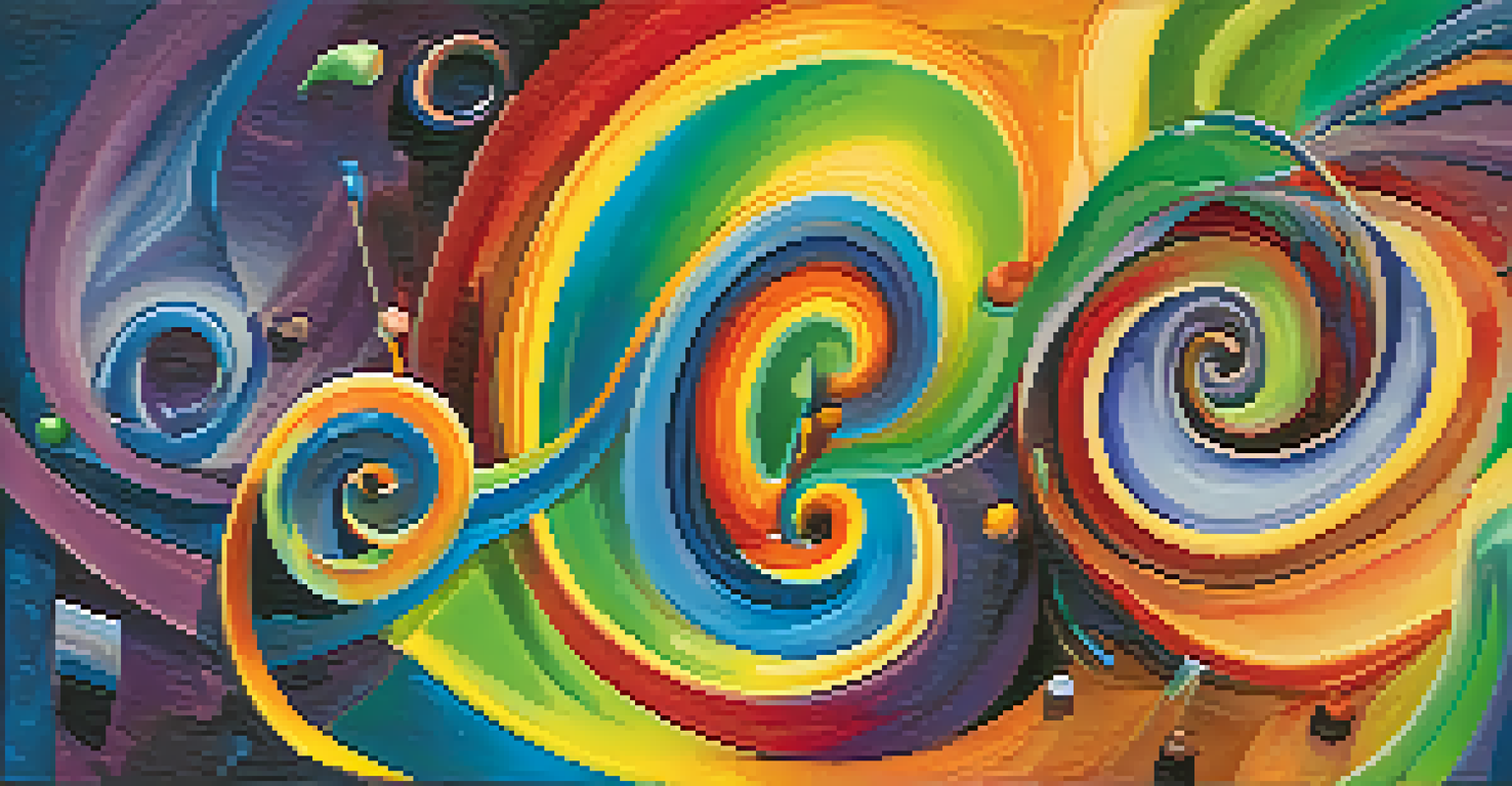Exploring Synesthesia Induced by Psychedelic Substances

What is Synesthesia and How Does it Work?
Synesthesia is a fascinating neurological condition where one sense involuntarily triggers another. For instance, someone might hear colors or see sounds, creating a unique sensory experience. This blending of senses occurs due to the brain's cross-wiring, leading to a rich tapestry of perception that is both intriguing and complex.
Synesthesia is a blending of the senses, a phenomenon that allows individuals to experience a world filled with vibrant colors, sounds, and textures that others may not perceive.
Imagine tasting a sweet fruit and simultaneously seeing a vibrant hue associated with that flavor. This vivid experience can enhance creativity and emotional depth, giving individuals a new lens through which to view the world. Synesthesia can manifest in various forms, with each individual's experience being uniquely personal.
While synesthesia is often a trait that some people are born with, it can also be induced. This brings us to the role of certain substances, particularly psychedelics, which can momentarily alter perception and create similar sensory overlaps.
The Science Behind Psychedelics and Perception
Psychedelic substances, such as LSD and psilocybin, have been shown to alter brain function in ways that enhance connectivity between different regions. This increased connectivity can lead to experiences resembling synesthesia, where the boundaries between senses blur. Research suggests that psychedelics may temporarily disable certain brain networks, allowing for a more fluid perception of reality.

For example, a person under the influence of psychedelics might describe the sound of music as having a color or texture, similar to how a synesthete might experience it. This phenomenon can lead to profound insights and a heightened appreciation for art, music, and nature. The brain's plasticity during these experiences allows for new connections and interpretations of familiar stimuli.
Synesthesia Blends the Senses
Synesthesia is a unique neurological condition where one sense involuntarily triggers another, creating intriguing sensory experiences.
Understanding the mechanisms behind these experiences not only sheds light on synesthesia but also opens the door to potential therapeutic applications of psychedelics, particularly in treating conditions such as PTSD and depression.
Historical Context of Psychedelics and Synesthesia
The connection between psychedelics and altered perception isn't new; it has been explored for centuries. Traditionally, various cultures have used plant-based substances in rituals to expand consciousness and enhance sensory experiences. These practices often resulted in descriptions akin to synesthetic experiences, where the participants reported vivid sensory overlaps.
Psychedelics are not just drugs; they are tools for exploring the mind, often revealing profound connections between our senses and the world around us.
For instance, the use of peyote in Native American spiritual ceremonies has been documented to induce a sense of unity with nature, often accompanied by enhanced sensory experiences. Similarly, in the 1960s, artists and musicians began to explore psychedelics, leading to a cultural revolution that celebrated synesthetic-like experiences through music and visual arts.
This historical context highlights a long-standing relationship between psychedelics and our understanding of consciousness, creativity, and sensory perception, suggesting that these substances can unlock new dimensions of human experience.
Personal Accounts of Synesthetic Experiences with Psychedelics
Many individuals who have experimented with psychedelics share their unique experiences, often describing a profound sense of interconnectedness and sensory blending. For example, a musician might report seeing colors while playing a certain chord or feeling textures when hearing specific melodies. These accounts paint a vivid picture of how psychedelics can enhance and alter sensory perception.
One artist shared that while under the influence of psilocybin, they experienced a symphony of colors and shapes that flowed synchronously with the music they were listening to. This not only influenced their artwork but also deepened their appreciation for the auditory experience itself. Such stories highlight the transformative power of these substances and their ability to enhance creativity and emotional expression.
Psychedelics Enhance Sensory Perception
Psychedelic substances can temporarily alter brain function, leading to experiences that resemble synesthesia by blurring the boundaries between senses.
These personal narratives not only enrich our understanding of synesthesia induced by psychedelics but also underscore the potential for therapeutic benefits, suggesting that these experiences can facilitate healing and personal growth.
Potential Therapeutic Benefits of Induced Synesthesia
The therapeutic potential of inducing synesthetic experiences through psychedelics is an exciting area of research. Some studies suggest that these experiences can help individuals process trauma, foster creativity, and enhance emotional well-being. By breaking down traditional sensory barriers, psychedelics may allow for new pathways of understanding and healing.
For example, patients with PTSD have reported breakthroughs in therapy sessions after using psychedelics, experiencing emotions and sensory memories in a way that felt more integrated. The blending of senses can create a more holistic perspective on their experiences, often resulting in profound insights that traditional therapies may not achieve.
As research continues, the implications for mental health treatment could be significant, providing new avenues for individuals seeking relief from emotional and psychological struggles through the lens of synesthesia.
Challenges and Risks of Psychedelic-Induced Synesthesia
While the potential benefits of psychedelics are promising, it's essential to understand the challenges and risks involved. Not everyone will have a positive experience, and for some, the blending of senses can lead to confusion or anxiety. This unpredictability makes it crucial to approach psychedelics with caution and respect.
Moreover, the legal status of many psychedelic substances complicates access to safe and controlled environments for exploration. Without proper guidance, individuals may find themselves in overwhelming situations, detracting from the potential benefits and leading to negative experiences.
Therapeutic Potential of Psychedelics
Inducing synesthetic experiences through psychedelics may provide therapeutic benefits, helping individuals process trauma and enhance emotional well-being.
Educating oneself and seeking support from knowledgeable practitioners can help mitigate these risks, ensuring that individuals can explore the fascinating intersection of psychedelics and synesthesia safely and effectively.
The Future of Research on Synesthesia and Psychedelics
As the stigma surrounding psychedelics continues to diminish, research into their effects on perception, including synesthesia, is gaining momentum. Scientists are increasingly interested in understanding how these substances can manipulate sensory experiences and contribute to our overall understanding of consciousness. This renewed interest opens the door for groundbreaking discoveries.
Future studies may explore not only the therapeutic applications of psychedelics but also their potential to enhance creativity and cognitive flexibility. By examining the relationship between synesthesia and psychedelics, researchers hope to uncover insights into the workings of the human mind and the nature of perception itself.

Ultimately, the future of this research could transform how we view psychedelics, not just as recreational substances but as powerful tools for understanding and enhancing human experience.